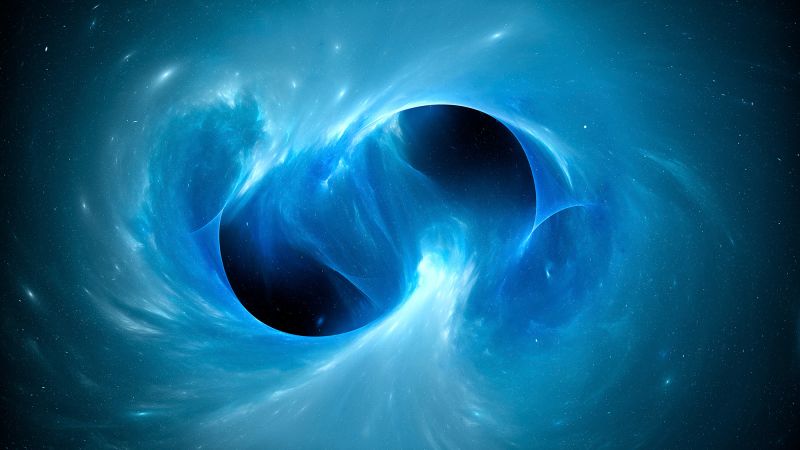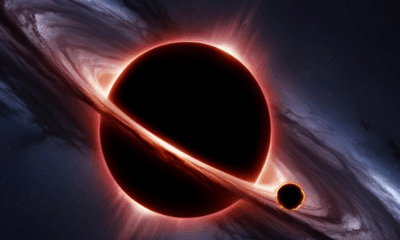Education
Astronomers Record Most Massive Black Hole Collision Ever

A groundbreaking discovery in astrophysics has revealed the most massive black hole collision ever recorded. Dubbed GW231123, this event involved two black holes, each exceeding the mass of 100 solar masses, merging in a spectacular display of cosmic forces. The collision was detected by the Laser Interferometer Gravitational-Wave Observatory (LIGO), with instruments located in Livingston, Louisiana, and Hanford, Washington.
The detection of faint ripples in space-time, known as gravitational waves, confirms the existence of this extraordinary merger, marking a significant achievement for the scientific community. Mark Hannam, head of the Gravity Exploration Institute at Cardiff University in the UK and a member of the LIGO Scientific Collaboration, emphasized the sensitivity of LIGO’s instruments: “These amazing detectors are really the most sensitive measuring instruments that human beings have ever built.”
Understanding the Unique Characteristics of GW231123
GW231123 stands out not only for its unprecedented mass but also for the unique characteristics of the individual black holes involved. Charlie Hoy, a research fellow at the University of Plymouth, noted that these black holes exist in a mass range that challenges current theories of black hole formation. Typically, black holes form from the collapse of massive stars, but the masses of the black holes in GW231123 fall within a so-called “mass gap,” suggesting they may have formed through a different process.
This mass gap, theorized to lie between approximately 60 and 130 solar masses, indicates that black holes of this size should not exist according to traditional stellar evolution models. If the black holes from GW231123 did not originate from stellar collapse, it raises questions about their formation. One hypothesis proposed by Hannam and his colleagues suggests that these black holes may be the result of previous mergers, creating a chain reaction of black hole collisions.
Implications for Black Hole Research
The implications of this discovery extend far beyond the event itself. Dan Wilkins, a research scientist at the Kavli Institute for Particle Astrophysics and Cosmology, highlighted the significance of gravitational waves in revealing previously hidden aspects of black hole formation and growth. “Gravitational waves are opening a really interesting window into black holes, revealing some intriguing mysteries,” he stated.
Before the advent of gravitational wave astronomy, black holes could only be observed indirectly through their interactions with surrounding materials. The ability to detect gravitational waves allows scientists to study black holes that do not actively emit light, offering a new perspective on their population and behavior.
Moreover, the rapid spin of the black holes in GW231123 adds another layer of complexity to our understanding. Most black holes detected thus far have been spinning relatively slowly, leading researchers to consider alternate formation mechanisms for this particular merger. As Sophie Bini, a postdoctoral researcher at Caltech, explained, “GW231123 challenges our models of gravitational wave signals, as it is complex to model such fast spins.”
Previously, the record for the most massive black hole merger was held by GW190521, which was approximately 60% smaller than GW231123. As technology advances, scientists anticipate discovering even more massive mergers in the future, potentially through new instruments like the proposed Cosmic Explorer in the United States and the Einstein Telescope in Europe.
The rapid progression of gravitational wave research underscores the maturity of the field. Imre Bartos, an associate professor at the University of Florida, noted that in less than a decade, researchers have moved from the first detection of gravitational waves to exploring phenomena that challenge established theories.
The discovery of GW231123 serves as a reminder of the mysteries that lie in the cosmos and the ongoing quest to understand the nature of black holes. As researchers continue to investigate these phenomena, future detections may provide further insights into the formation and evolution of black holes, illuminating an area of astrophysics that has long been shrouded in mystery.
-

 Technology5 months ago
Technology5 months agoDiscover the Top 10 Calorie Counting Apps of 2025
-

 Health2 months ago
Health2 months agoBella Hadid Shares Health Update After Treatment for Lyme Disease
-

 Health3 months ago
Health3 months agoErin Bates Shares Recovery Update Following Sepsis Complications
-

 Technology4 months ago
Technology4 months agoDiscover How to Reverse Image Search Using ChatGPT Effortlessly
-

 Technology1 month ago
Technology1 month agoDiscover 2025’s Top GPUs for Exceptional 4K Gaming Performance
-

 Technology2 months ago
Technology2 months agoElectric Moto Influencer Surronster Arrested in Tijuana
-

 Technology5 months ago
Technology5 months agoMeta Initiates $60B AI Data Center Expansion, Starting in Ohio
-

 Technology5 months ago
Technology5 months agoRecovering a Suspended TikTok Account: A Step-by-Step Guide
-

 Health4 months ago
Health4 months agoTested: Rab Firewall Mountain Jacket Survives Harsh Conditions
-

 Lifestyle5 months ago
Lifestyle5 months agoBelton Family Reunites After Daughter Survives Hill Country Floods
-

 Technology4 months ago
Technology4 months agoHarmonic Launches AI Chatbot App to Transform Mathematical Reasoning
-

 Technology3 months ago
Technology3 months agoUncovering the Top Five Most Challenging Motorcycles to Ride





















